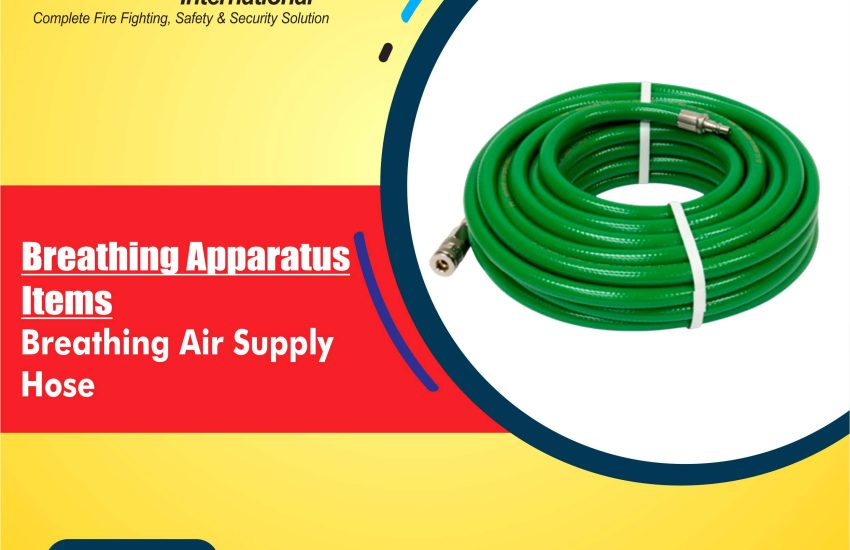Breathing Air Supply Hose is essential for providing clean air to workers in hazardous environments. These hoses connect workers to a reliable air source, ensuring safety and health in industries like firefighting, industrial work, and rescue operations. This guide will explain the features, benefits, and tips for choosing the best Breathing Air Supply Hose.
What is a Breathing Air Supply Hose?
A Breathing Air Supply Hose delivers clean air from a compressed air source to respiratory protection equipment. Workers use these hoses in areas with poor air quality, such as confined spaces or hazardous environments. The hose ensures a continuous supply of breathable air, preventing workers from inhaling toxic substances, smoke, or harmful gases.
Key Features of Breathing Air Supply Hoses
- Durability and Strength These hoses are made from tough materials like rubber or polyurethane. They resist abrasions, impacts, and chemicals, ensuring a long service life even in harsh conditions.
- Flexibility and Lightweight Despite being durable, the hoses are lightweight and flexible, allowing workers to move freely without feeling weighed down.
- Chemical Resistance Many hoses feature chemical-resistant properties, making them ideal for industries dealing with chemicals, such as manufacturing or hazardous waste handling.
- Pressure and Temperature Resistance Breathing air supply hoses are built to handle high-pressure air supplies. They perform well in both hot and cold environments, ensuring a steady air supply in various conditions.
- Compatibility with Respirators These hoses work with many types of respiratory protection, including Airline Respirators, Self-Contained Breathing Apparatus (SCBA), and PAPR (Powered Air-Purifying Respirator) systems, ensuring workers get a reliable air supply while using their equipment.
Benefits of Using a Breathing Air Supply Hose
- Increased Safety The hose provides a steady flow of breathable air, reducing the risk of inhaling toxic gases or low oxygen levels in dangerous environments.
- Improved Efficiency With an uninterrupted air supply, workers can focus on their tasks without worrying about running out of air, improving productivity.
- Comfort and Mobility The hose’s lightweight and flexible design allow workers to move easily while staying connected to their air source, essential in tight spaces or physically demanding tasks.
- Cost-Effective Solution These hoses are designed for durability, reducing the need for frequent replacements and offering a long-term solution for respiratory protection.
- Easy Maintenance Cleaning and inspecting the hoses is simple, helping maintain the quality of the air supply and extending the hose’s lifespan.
How to Choose the Right Breathing Air Supply Hose
Consider these factors when selecting the best Breathing Air Supply Hose for your needs:
- Length of Hose Ensure the hose is long enough to allow workers to move freely within the work area. Consider the distance between the air supply source and where workers will operate.
- Material Choose a hose made from materials that suit the environment. Rubber hoses are durable, while polyurethane hoses are lighter and more chemical-resistant.
- Pressure Rating Match the hose’s pressure rating with your air supply system. Ensure it can handle the required pressure for the specific tasks and environments.
- Temperature Range Select a hose that performs well in the temperature conditions of your work environment, whether in extreme heat or cold.
- Compatibility with Respirators Make sure the hose connects securely with your respirator system, whether it’s an Airline Respirator, SCBA, or PAPR.
- Safety Standards Compliance Look for hoses that meet safety and quality standards, such as those set by OSHA or NIOSH. Certified hoses ensure reliability and performance.
Types of Breathing Air Supply Hoses
- Airline Respirator Hoses Airline respirator hoses connect Airline Respirators to an external clean air source. These hoses are usually longer, offering workers more mobility without interrupting their air supply.
- Self-Contained Breathing Apparatus (SCBA) Hoses SCBA hoses link Self-Contained Breathing Apparatus (SCBA) units to an air source. These hoses deliver air directly to the user’s face piece or mask, providing safety in confined or hazardous spaces.
- Powered Air-Purifying Respirator (PAPR) Hoses PAPR hoses supply filtered air to the user’s face piece from a Powered Air-Purifying Respirator unit. These hoses ensure workers receive clean, breathable air that has been purified of contaminants.
How to Maintain Your Breathing Air Supply Hose
Maintaining your Breathing Air Supply Hose is essential to ensure its performance. Here’s how to care for it:
- Inspect Regularly Check for cracks, abrasions, or any signs of wear. Ensure connections are secure and that there are no leaks in the hose.
- Clean After Use Clean the hose after each use to remove dirt or debris. This helps maintain air quality and extends the hose’s lifespan.
- Store Properly Store the hose in a cool, dry place to avoid damage. Avoid leaving it in direct sunlight or exposing it to extreme temperatures, which can affect its durability.
- Replace Damaged Hoses If the hose shows signs of damage, replace it immediately. Damaged hoses can compromise air quality and safety, so timely replacement is essential.
Conclusion
A Breathing Air Supply Hose is an essential part of respiratory protection systems, providing workers with clean, breathable air in hazardous environments. By choosing the right hose for your needs and maintaining it properly, you can ensure the safety, comfort, and productivity of your workforce. Whether you’re in firefighting, industrial work, or confined space entry, a high-quality air supply hose is crucial for ensuring worker protection.


